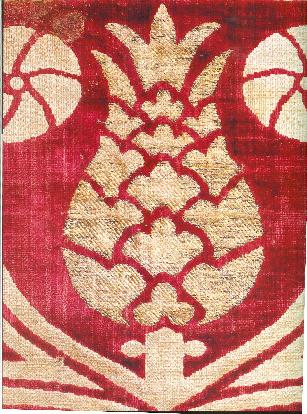| Dear R. John and you all, It would be more accurate to speak of chatma
cushion cover (brocaded velvet) instead of velvet. As you have noticed it,
one of the distinctive feature of these cushion covers are the “six”
lappets appearing at each end. This old tradition survived into the 18th
century. According to N. Gürsu (page 161-163), during the 17th century,
the designs used in these cushion covers were similar to the designs
employed in other chatma fabrics or, they were conformed to the shape of
the cushion cover or, as in the two examples you show, resembled designs
of book cover, with a central medallion and four corner decorations. The
designs typical of the beginning of the 17th century which were composed
of an infinitely repeating pattern of carnations, palmettes, round
medallions and stellar flowers are totally absent from 18th century
cushion cover. At the other hand, the arrangement of a symmetrical pattern
in conformity with the shape of the fabric, typical of the 17th century,
is still in evidence in the 18th century. After the end of the 17th
century the lappets at each end begin to be separated from the main field
by a border of stylized flowers. So knowing how the design evolved is of
great help for dating these cushion covers. Thanks,
Daniel |
 Here is a close-up detail of this first piece.
Here is a close-up detail of this first piece.  Here is the second Topkapi piece, this
one with quite a bit more white.
Here is the second Topkapi piece, this
one with quite a bit more white.  The exhibition catalog indicates that both of these pieces are from the
17th century. Notice again that these court velvets have a quite narrow
range of color and draw on strong graphics for their aesthetic merit. The
yastik format is one that is also encountered in later village wool pile
weavings. Here are two from Brian Morehouse's book, Yastiks, 1996, that
might be seen to retain echoes of these court velvets. The first one
retains the border-less format of the court yastiks.
The exhibition catalog indicates that both of these pieces are from the
17th century. Notice again that these court velvets have a quite narrow
range of color and draw on strong graphics for their aesthetic merit. The
yastik format is one that is also encountered in later village wool pile
weavings. Here are two from Brian Morehouse's book, Yastiks, 1996, that
might be seen to retain echoes of these court velvets. The first one
retains the border-less format of the court yastiks.  Sometimes versions of yastiks
acquire borders and become "little rugs," so to speak.
Sometimes versions of yastiks
acquire borders and become "little rugs," so to speak.  And in fact larger rugs do
occur that have lappets (the little shield-like devices at the ends).
Regards, R. John Howe
And in fact larger rugs do
occur that have lappets (the little shield-like devices at the ends).
Regards, R. John Howe